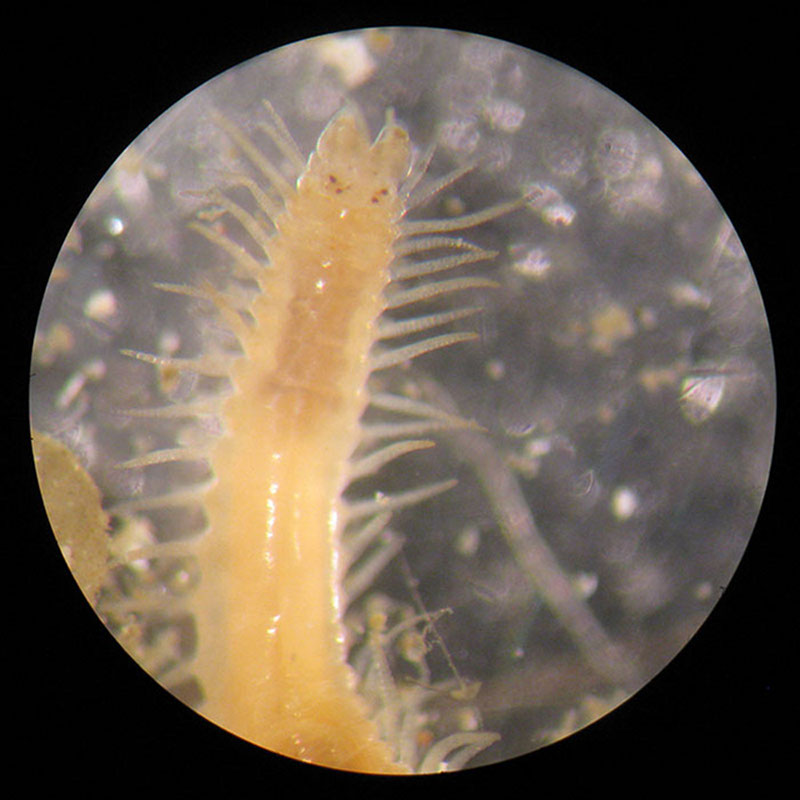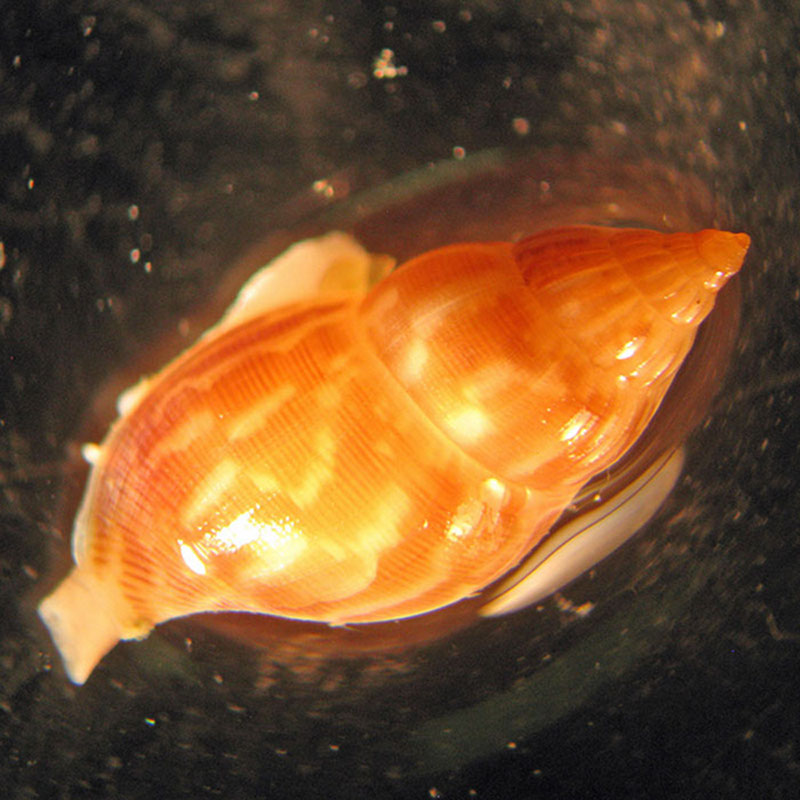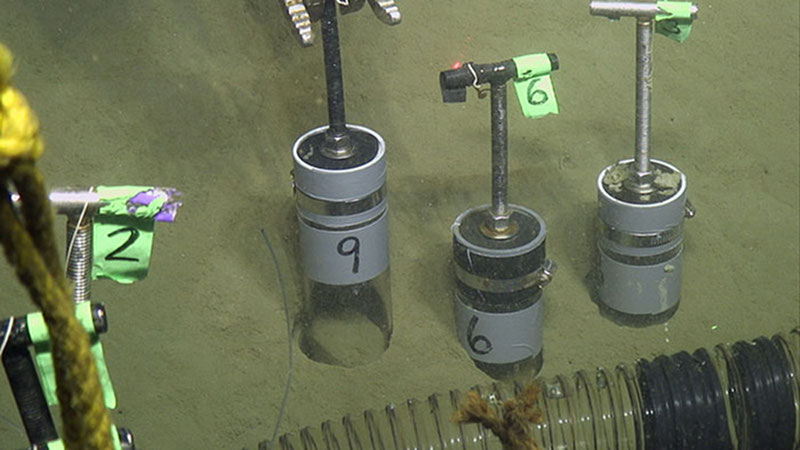
By Amanda Demopoulos, Benthic Research Ecologist - U.S. Geological Survey
May 7, 2013

(L to R) Jennifer McClain-Counts, Jill Bourque, and Amanda Demopoulos prepare to extract a sediment sample from one of the push cores deployed by Jason. Image courtesy of Deepwater Canyons 2013 - Pathways to the Abyss, NOAA-OER/BOEM/USGS. Download larger version (jpg, 745 KB).
The deep sea is rich with life, from fish to invertebrates to microbes. Hidden within the mud and rocks are numerous small animals (less than 1 millimeter) that are almost invisible to the naked eye. While small, they represent a major component of deep-sea diversity.
My research focuses on understanding and identifying the communities found within deep-sea sediments, called infauna, and characterizing their role in deep-sea food-webs. The basic questions that I’m addressing include: How many animals are in the sediment? What is the community composed of and who are the rare or most abundant species? What interactions occur among these species, including who is eating what or whom?
Basic patterns in species composition, abundance, and diversity can all be a function of the environment in which they live. By teaming up with different scientists with complementary goals, we obtain a more complete picture of deep-sea canyon environments and the fauna that thrive within them, including characterizing food availability to the seafloor.

A syllid polychaete worm found within a dead Desmophyllum coral skeleton found along the canyon wall. Image courtesy of Craig Robertson, Deepwater Canyons 2013 - Pathways to the Abyss, NOAA-OER/BOEM/USGS. Download larger version (jpg, 672 KB).
As a benthic ecologist, I study animals associated with the seafloor, whether in coral reefs, deep-sea mud, or wetlands. The specific groups I am interested in include the meiofauna (less than 0.3 millimeters) and macrofauna (greater than 0.3 millimeters). We use metal mesh screens to separate these animals from the sediment. Due to their small size, we must use very careful techniques to collect and preserve these animals and a microscope is required for identification.

An unidentified gastropod (Family: Columbellidae) collected with Jason’s suction sampler from a rock wall at 444 meters. Image courtesy of Amanda Demopoulos, Deepwater Canyons 2013 - Pathways to the Abyss, NOAA-OER/BOEM/USGS. Download larger version (jpg, 820 KB).
Sediment fauna provide a variety of ecosystem functions and services, including serving as a food source for other animals and modifying the sediment environment. For example, animals can alter sediment chemistry just by creating burrows and moving through the mud, much like earthworms do in the garden. This activity may make the benthic environment more or less hospitable for other species. These ecosystem functions may influence what species live in the sediments, as well as associated species interactions.
Benthic infauna are often examined to track the impact of disturbance on marine environments, including pollution, because they are largely sedentary and they respond rapidly to changes in their environment. Thus, small animals can serve as barometers of ecosystem health.
I find these organisms fascinating because they come in so many different shapes and patterns. Some have plates, like armor protecting their soft bodies, while others are very colorful, or have hairs and patterns that are unique. These characteristics are used to help us identify the animals. I enjoy sorting and picking the animals live, fresh from being collected on the seafloor, so that I can watch them in action.
Sometimes we find animals that are related to those that we see every day at the beach, including miniature seastars, urchins, worms, or clams. After examining our samples collected last year from the middle of Baltimore Canyon, we found that the sediment communities changed with depth along the central axis, with polychaete worms and crustaceans dominating the sediment scape.
This year, I’m targeting collections near the canyon walls where hardbottom cliffs meet soft bottom mud. These transition zones are often characterized by distinctive fauna that may be capitalizing on enhanced food supply and varying current regime. We may find that the communities of benthic infauna living adjacent to hardbottom differ from the central canyon sediments.

Jason inserts push cores into the muddy bottom with one of its manipulator arms. Image courtesy of Amanda Demopoulos, Deepwater Canyons 2013 - Pathways to the Abyss, NOAA-OER/BOEM/USGS. Download larger version (jpg, 609 KB).
Sediments from the seafloor are collected using a variety of gear, including push cores and Ekman box cores operated by the Jason remotely operated vehicle (ROV) or box cores deployed from the ship. A push core is a 50-centimeter (20-inch) clear plastic tube with a T-handle on top. Ekman box cores are a little larger than the push cores, but each box provides four separate samples for analysis.
When the ROV returns to the ship, I remove the cores, place them into a cold (2°C, or 35ºF) room, then extrude each core on a plunger that pushes the mud to the top. We slice sections of the sediment down to 10 centimeters (4 inches), and preserve each section for further processing.
Back at the lab, the sediment slices are sieved through a screen to separate the animals from the mud. My lab team, including Jill Bourque and Jennifer McClain-Counts, plus many others, help sort and identify the animals under a microscope. Most of the animals live where all the action is, at the surface of the sediment (upper 2 centimeters). This is the most hospitable part of the mud, where their food is most plentiful and oxygen concentrations are the greatest. After identifying the infauna, we will compare them to different community studies from other soft-sediment environments to characterize the abundance and diversity of the canyon infauna.
I’m very excited to see what we discover from this cruise after returning to the lab and sorting through these collections. Ultimately, there is high potential for discovering new species and this work enhances our understanding of species interactions, given what little we know about the small animals living within deep-canyon marine sediment. However, the discoveries will have to wait until we return home to the lab.